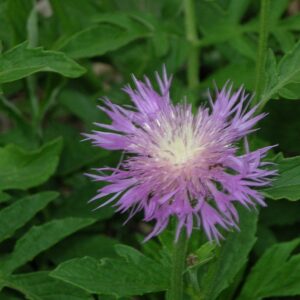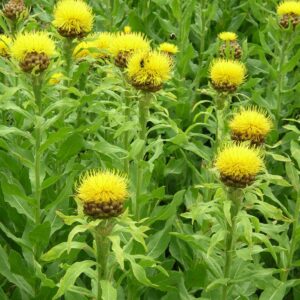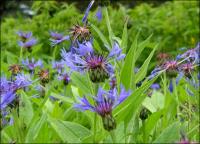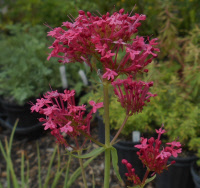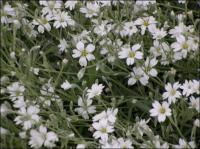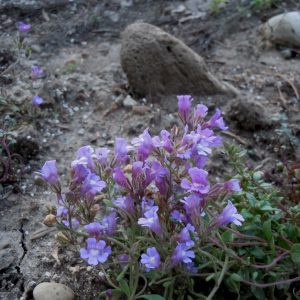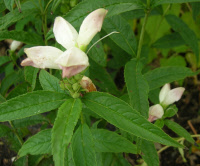Perennials & Biennials
Showing 97–104 of 485 results
-
Centaurea atropurpurea Red knapweed Z 5-9
Ruby-red to merlot, soft thistle-like blooms June-August, if deadheaded, atop silvery, deep cut foliage, rare.
OUT OF STOCK
Ruby-red to merlot, soft thistle-like blooms June-August, repeating if deadheaded, atop silvery, deep cut foliage, rare.
Size: 4’ x 2’
Care: sun in moist well-drained to well-drained soil
Native: meadows of Carpathian mountains
Wildlife Value: Deer resistantCentaurea named for the Centaur, half-horse and half-man who was a mythical healer. Red knapweed described by French entomologist Guillaume Antoine Olivier (1756-1814). Grown at America’s 1st botanic garden, Elgin Botanic Garden 1811.
-
Centaurea dealbata Persian cornflower Z 3-8
Rosy dome shaped blossoms with fringed petals May-June, deadhead for rebloom
Rosy dome shaped blossoms with fringed petals May-June, deadhead for rebloom
Size: 2-3' x 2'
Care: sun in moist well-drained soil
Native: CaucasusNamed for the Centaur, half-horse and half-man who was a mythical famous healer. This species collected before 1803.
-
Centaurea macrocephala Armenian basketflower, Globe centaurea Z 3-9
Picture a Canada thistle at its peak –this looks like a magnificent, cheerful yellow version – but it’s not a thistle July-August.
Picture a Canada thistle at its peak -this looks like a magnificent, cheerful yellow version – but it’s not a thistle. July-August
Can not ship to: Maryland and Washington
Size: 3-4' x 18-24"
Care: sun in well-drained to moist well-drained soil
Native: CaucasusCentaurea is named after the Greek mythological figure a Centaur named Chiron, half-horse, half-man. Macrocephala means “big-head” referring to the big flowers. Philadelphia nurseryman McMahon sent this to Jefferson in 1812.
-
Centaurea montana Mountain bluet, Blue bottle, Bachelor’s button Z 3-8
True blue, with a touch of pink near the center, spidery flowerheads in May-June and sporadically thereafter or all summer if you deadhead.
True blue, with a touch of pink near the center, spidery flowerheads in May-June and sporatically thereafter or all summer if you deadhead.
Size: 18" x 24"
Care: Sun - part shade, moist well-drained soil.
Native: Mountains of EuropeCentaurea is named after the Greek mythological figure, a Centaur named Chiron, half-horse, half-man. Ovid claimed that the plant cured a wound in Chiron’s foot from an arrow hurled by Hercules. Introduced from the Pyrenees and grown in English cottage gardens since the 1500’s.
-
Centranthus ruber Jupiter’s beard, Red Valerian, Pretty Betsy Z 5-8
Clusters of crimson, star-shaped florets atop 2’ stems bloom their heads off ALL summer into fall.
Clusters of crimson, star-shaped florets atop 2’ stems bloom their heads off ALL summer into fall.
Size: 24-36”x 12”
Care: Sun in well-drained alkaline soil, drought tolerant
Native: Mediterranean
Wildlife Value: attracts butterflies, bees and hover flies.Centranthus is from the Greek meaning “spurred flower.” According to Culpepper, an English herbalist from the early 1600’s, this plant comforts the heart and stirs up lust. Parkinson, in 1629 describes it “of a fine red colour, very pleasant to behold.”
-
Cerastium biebersteinii Mouse ear Z 4-7
White felt-like foliage, white flowers in spring. “Ornamental foliage dwarf plant with beautiful silvery tinted foliage,” Bliss & Sons Catalog 1872.
White felt-like foliage, white flowers in spring. “Ornamental foliage dwarf plant with beautiful silvery tinted foliage,” Bliss & Sons Catalog 1872.
Size: 6" x spreading
Care: Sun in well-drained soil
Native: TauriaCerastium is from the Greek keras meaning “horn” because of the shape of the seed capsule. Used as a groundcover under tropical plants in Victorian gardens. In 1913 Sanders identified it as a “good edging or rockery plant.” Grown in American gardens since 1860’s.
-
Chaenorhinum glareosum Dwarf snapdragon Z 5-9
Rare plant. Spires of tiny purple to blue trumpets with yellow throats spring, summer & fall. Love this itsy plant.
Rare plant. Spires of tiny purple to blue trumpets with yellow throats spring, summer & fall. Love this itsy plant.
Size: 4” x 9-12” semi-trailing cushion
Care: sun to part-shade in well-drained soil
Native: Spain
Wildlife Value: Attracts bees, butterflies and birds.1st described in 1838. Chaenorhinum means “honey lotus” in Greek.
-
Chelone glabra White turtlehead Z 3-8
Spikes of pink over-tones on white, two-lipped, turtlehead shaped blooms in fall
Spikes of pink over-tones on white, two-lipped, turtlehead shaped blooms in fall
Size: 24-36” x 12”
Care: sun to part shade in moist to moist well-drained soil, tolerates clay.
Native: eastern North America incl Wisconsin
Wildlife Value: Pollen for bumblebees. Breeding site for Baltimore Checkerspot butterflies. Deer resistant.The name Chelone originated with French colonial settlers in Nova Scotia before 1700. They called this “La Tortue,” meaning “turtle” in French. The word chelone is Greek for tortoise. A tea brewed from the leaves was said to increase the appetite.


